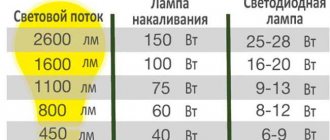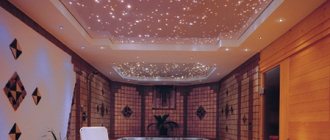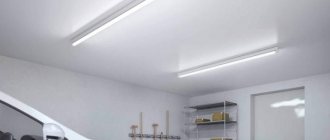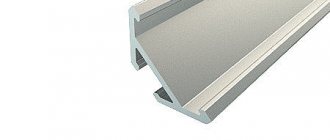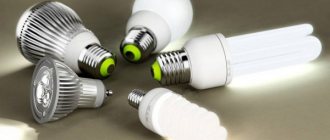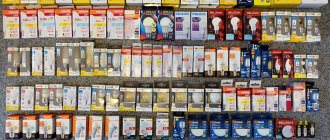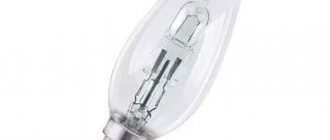- Operating principle of LED strip
- Basic criteria for choosing LED strip
- Selecting LED strip by parameters
- How to determine the quality of LED strip?
- TOP manufacturers of LED strips
- How to choose a power supply for LED strip?
- Advantages and disadvantages
- FAQ
An LED strip is selected for a specific task, taking into account its location, requirements for brightness, glow color and other characteristics. We will tell you in detail how to choose the right LED strip for basic lighting and decorative lighting, which LED strip to choose for residential premises and outdoor installation. You will learn about the criteria for choosing a high-quality strip, and how low-quality LED strips from the super economy segment differ.
TOP manufacturers will help you decide on the most suitable brand in terms of quality/price. A separate section is devoted to the correct selection of a power supply and calculating its power taking into account the load. And at the end of the article you can read the advice of experts and an analysis of the pros/cons of using tape.
Specific electrical power
Specific electrical power shows how much energy 1 meter of LED strip consumes. Based on this parameter, energy consumption is calculated and a power supply is selected. It is stated that all tapes from the experiment consume 9.6 W/m.
| Declared power, W | Real power, W | Deviation | |
| Sample No. 1 | 9,6 | 9,4 | 0,2 |
| Sample No. 2 | 9,6 | 7,4 | 2,2 |
| Sample No. 3 | 9,6 | 8,2 | 1,4 |
| Sample No. 4 | 9,6 | 7,5 | 2,1 |
Sample 1 tape showed approximately equal to the declared power value. The LED strip of sample 3 has a significant deviation, but is within the normal range. For tapes of samples 2 and 4, we observe a large difference in performance - more than 2 Watts. This is fraught with incorrect calculations of energy consumption and overpayment for power supplies.
Knowing the actual consumption (specific electrical power) and luminous flux, we can calculate energy efficiency, i.e. how many lumens of brightness each tape with 1 Watt can provide.
| Efficiency, lm/W | |
| Sample No. 1 | 84 |
| Sample No. 2 | 57 |
| Sample No. 3 | 39 |
| Sample No. 4 | 41 |
Tape 1 is 1.5 times higher than the closest competitor in price and more than 2 times higher than the cheapest option. Samples of tapes 3 and 4 are significantly inferior in brightness.
Luminous flux (brightness): 2 times difference
Luminous flux is one of the most important criteria when selecting an LED strip. It directly determines the light level. Let's compare the obtained brightness values of the tapes with the data declared by the manufacturers:
| Declared value, lm/m | Real value, lm/m | |
| Sample No. 1 | 820 | 786 |
| Sample No. 2 | 450 | 425 |
| Sample No. 3 | NO | 316 |
| Sample No. 4 | NO | 310 |
From which we can conclude the following. Inexpensive tapes, samples 3 and 4 have the lowest lm/m. Sample 1 has the highest level of luminous flux, and its value is 96% the same as declared. For sample 2, the obtained indicator is almost 2 times lower than for the tape of sample 1, and coincides with the value specified by the manufacturer.
We know the price of 1 meter of tape and its real brightness (Luminous flux), which means we can calculate the cost of one lumen:
- Sample No. 1: 464 rub/m \ 786 lm/m = 0.6 rub/lm
- Sample No. 2: 206 rub./m \ 425 lm/m = 0.48 rub. lm
- Sample No. 3: 110 rub/m \ 316 lm/m = 0.35 rub/lm
- Sample No. 4: 70 rub/m \ 310 lm/m = 0.22 rub/lm
Let's not draw conclusions for now and continue the comparison.
No. 5. Color direction
LED strips can be either single-color or provide multicolor lighting. The former are abbreviated SMD, and multi-color ones are abbreviated RGB. The color of the lighting is determined by the shade of the installed LED crystals.
Colored crystals are more expensive than their white counterpart. The most expensive option is crystals of intermediate shades - in this case, a phosphor is applied to the crystal, or the LED is represented by two crystals of basic colors at once.
White light will change tone, depending on the color temperature:
- 6000 K and above – cold range of the spectrum;
- neutral shade - 2700 K to 4000-4500 K;
- the warm spectrum is a temperature up to 2700 K.
There is a multi-white tape option, where the temperature of the white light can be varied by settings. Another important indicator is CRI, or color reproduction accuracy. An indicator of more than 70 is considered sufficient, but more than 90 is optimal.
Cool white produces bright but sterile illumination, similar to medical lamps, which can distort the perception of colors. For living rooms, warm white light will be optimal; for the work area, it is better to stay with neutral light.
Good and bad LED strips on a printed circuit board
The types and types of tapes are off the charts in their diversity. Printed circuit boards on which LEDs are placed can also be made in various versions. Flexible printed circuit board (FPC) is very popular. And first of all, an ordinary buyer can easily determine and understand how bad the tape is - look at it closely. Many people believe that the quality of the diode strip is determined by the color of the mask. I don’t know where this statement came from.
The quality of an FPC board is determined only by the thickness and method of applying the copper conductors. Good boards have rolled copper, which is what you see on regular boards. FPC must be double sided. Such a tape has low resistivity, the voltage drop is the same along the entire length, and all chips shine equally. This is clearly visible when the tape is connected twice (on both sides).
In bad boards, copper is applied by sputtering. I won’t tell you what diffuse spraying is, and you don’t need it. The main thing is to understand and understand that such copper has a small thickness and a heterogeneous structure. Diode degradation can reach up to 90 percent.
Therefore, to check the tape, ask the seller for a piece of tape. They have special samples for this. Peel off the sticky layer and look at the underside. If the copper conductor is visible, then the board is double-sided and the tape is of good quality. Nobody will bother and release a tape with a good board and bad LEDs. If it is not clear whether the board is double or not, expose the area with the copper conductor on the front part. And scratch it with your fingernail. Sprayed copper will be erased quite easily. In this case, you can safely turn around and leave the store. Well, or look at another copy. But I don’t think that if a store has at least one cheap, low-quality product, then it will have a good one.
Well, that's all. We've looked at a number of principles for identifying good quality LED strips. I already talked about the best ones. One tape for one room will be considered the best, and the second, despite the fact that it is made with high quality, will not be the best use.
Length calculation
The length of the LED strip is determined by measuring the area where it will be installed. When installing along the perimeter, the length and width of the room are measured, the numbers must be counted and multiplied by 2.
When selecting a strip for a block that already exists, the length is determined not by measurement, but by calculation.
For example, for a 12 V unit with a power of 60 W, the cut-off power should be 20% less, that is, 48 W. The size of the strip depends on the power of one chip. For example, for an SMD 5050 LED, the chip power is 0.24 W, a segment containing 200 diodes (48/0.24) can be connected to the source.
A power supply is not required if you connect an LED lamp or spotlight with a built-in driver.
Appearance and durability
Let's start with the appearance - the only parameter available to the buyer for a quick assessment. Visually we can evaluate how evenly the diodes are installed, and by touch the thickness of the board of the tape itself. The boards of low-quality tapes are thin, and the LEDs “dance,” which indirectly characterizes the low level of production.
LED strips with sufficient board thickness are more resistant to mechanical damage. A thickness of 0.30-0.35 mm is considered normal. Tapes with a thickness of less than 0.20 mm. may be damaged already at the installation stage.
What values did the experiment participants show:
- Sample No. 1—0.3 mm;
- Sample No. 2—0.16 mm;
- Sample No. 3—0.20 mm;
- Sample No. 4 - 0.15 mm.
Only two manufacturers remain within the norm: Sample No. 1 and Sample No. 3. Now let's pay attention to how the diodes are installed.
- On sample 3, the LEDs are installed unevenly, which indicates an incorrect soldering mode. Indirectly characterizes the low level of production. The mounting adhesive on the back side is of unknown origin; it will dry out and peel off in 2-3 months.
- Tapes sample 2 and 4 have the same disadvantages - a potentially peeling adhesive layer. However, the LEDs themselves are installed smoothly, without distortions - the strip was produced on professional equipment. The adhesive tape on the back side is of unknown origin and is highly likely to dry out and peel off from the tape.
- Sample 1 is characterized by an even installation of the LEDs, without displacement or distortion. An undeniable advantage is 3M tape. This is the most famous manufacturer of adhesive materials. The adhesive tape does not turn yellow or peel off over time and adheres equally firmly to different surfaces.
Supply voltage
Voltage is of great importance in the power supply of any electronic product, therefore all types of LED strips are conditionally classified according to this parameter. Initially, tapes were produced only for a power supply unit (PSU) with an output voltage of 12V, but with the advent of powerful LEDs, the current load on printed conductors increased significantly, which caused their frequent overheating. The way out of the situation was the introduction of new nutrition standards:
- from DC power supply voltage 24V and 36V;
- from AC mains voltage 220V.
Tapes designed for power supply from a 220V AC network are connected via a rectifier. As a rule, the package includes a unified cable with a built-in diode bridge and a corresponding connector.
